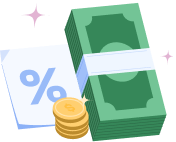Table of Contents
Your credit utilization ratio is one of the most important—and often overlooked—factors affecting your credit score. Simply put, it’s the percentage of your available credit that you’re currently using, and keeping it low can significantly improve your score quickly. Suppose you’re looking for quick wins on your journey to better credit. In that case, this guide will teach how you can improve credit utilization to boost your credit score quickly offers the strategies you need to make meaningful progress quickly.
Your credit score is a key indicator of your financial future in the complex world of personal finance. Whether you’re applying for a mortgage, an apartment, or a new job, a good credit score will open doors, and a bad one will close them. What is credit use? Why is it important? This article will explain all of that and the calculated measures you can take right now to increase it quickly.
Why Credit Utilization Matters
A person’s credit consumption is the proportion of their available revolving credit currently being used, typically from credit cards. To calculate it, add up all your credit card balances and divide that total by your credit limit.
- Credit scoring systems, especially FICO and VantageScore, heavily emphasize credit utilization. After payment history, it is the second most important factor and accounts for over 30% of your FICO score.
- A low utilization ratio demonstrates to lenders that you are fiscally responsible and do not rely too heavily on borrowed funds. Numerous recommendations exist for better financial management, self-control, and lower risk, all of which can lead to better loan conditions and credit ratings.
- However, a high utilization rate may indicate financial troubles even with on-time bill payments. Lenders may be wary if they see this and assume you rely too much on credit. Using your credit responsibly is key to maintaining and quickly improving a high score.
Read related blog: How Staying Organized Can Improve Your Credit Score and Financial Health
Find Out Your Current Credit Utilization
You must first know your present credit usage ratio to manage your credit better. A significant factor in your credit score, this statistic reflects how much of your available credit you use. To find it, first total all of your present credit card debt. Add the credit limits from all of your cards, then. To determine a percentage, divide the overall balances by the credit limit, then multiply by 100.
Your credit use is 20%, for instance, if your total credit limit is $10,000 and you have a $2,000 balance across your cards. This is computed by dividing 2,000 by 10,000 and then by 100. Keeping your credit use around 30% will help you to keep a decent credit profile. For the best credit score, try to keep it below 10%. Many believe paying bills on time is sufficient, but maintaining large balances—such as utilizing 80% of your credit—can lower your score even with regular payments.
Using your credit report or a reputable credit monitoring tool, review your most current credit limits and balances to guarantee accuracy. Maintaining knowledge helps you to make wiser financial decisions and change your spending patterns.
Fast Ways to Lower Your Credit Utilization
Need to reduce your credit usage immediately. The good news is that you can achieve rapid progress by employing several strategic tactics. We should investigate each possibility in detail:
Pay Down Credit Card Balances Early
- The majority of people with credit card debt pay it off on the due date. A credit card company’s record of your outstanding balance is updated with the credit bureaus on the date of statement closure, not the day of payment due.
- Spread out your payments throughout the month to keep the total down. You will see a decrease in your utilization, even if your total spending remains unchanged, because this ensures a reduced amount is revealed to the credit agencies. For example, if you typically spend $1,000 monthly and prefer to pay after the statement closes, your reported amount will be $1,000. If you pay up your amount in two $500 installments before your statement date, your reported balance can be zero or almost zero, meaning your consumption has increased.
Request Higher Credit Limits
- Inquire about increasing your credit limit with your card issuer.
- A higher credit limit automatically decreases your utilization percentage, regardless of whether your balance remains unchanged. This is how it works. The benefit will be nullified if you start spending more than your upper limit on other things immediately. Some credit card companies allow you to request a limit increase online, bypassing the need for a hard credit check.
- Emphasizing good behavior, on-time payments, increased income, and reduced debt will improve your acceptance odds.
Spread Purchases Across Multiple Cards
Instead of charging everything to one card, spread out your purchases among multiple cards if you really must use credit. Instead of charging $900 on a $1,000 limit card, which would result in 90% usage, you might split it over three $1,000 limit cards ($300 each = 30% usage). The reason is that individual and aggregate card usage rates are factored into credit rating models. A poor score will still be reflected even if only a single card has a high usage rate.
Avoid Closing Old Credit Cards
You can simplify your life by closing unused or obsolete credit cards; however, doing so may negatively impact your credit score. Your utilization ratio will rise regardless of whether your total debt remains the same after closing a card because your total available credit will be reduced.
Take the following scenario: If you have $15,000 available credit but $5,000 in credit card debt. Your consumption would be approximately 33% of that amount.
Closing a $5,000 credit card account lowers your available credit to $10,000 and significantly impacts your credit score due to higher use. Keep your older cards active, especially the ones with no annual fee and a long history.
Monitor Balances and Set Up Alerts
- It’s crucial to stay one step ahead of your balance. Most banking apps and credit card websites allow you to set up balance notifications. When your balance approaches a certain threshold, you can set up alerts to notify you.
- Respond quickly to unexpectedly high charges. Avoid unintentional increases that lower your consumption-to-use ratio.
- Set up multiple alerts, such as one at 20% usage and another at 30%, to ensure you’re always completely informed before an issue arises.
Read related blog: How to Recover Your Credit Score After Financial Setbacks
How Credit Monitoring Tools Can Help
In today’s technologically advanced society, carelessly managing your credit is not an option. Credit monitoring apps offer real-time access to your credit reports, utilization ratios, and trends. Some examples of these apps are Experian, Beem, and Credit Karma.
- A simple way to keep track of your spending across all accounts is to use credit monitoring software. Beem’s Credit monitoring tool checks your credit score progress in real time and sends on-time, detailed reports from the credit bureau.
- These platforms will notify you if there is any suspicious activity or if your balance unexpectedly increases.
- Find out what steps you can take to improve your credit score based on your spending patterns.
- Recognize whether someone is dishonest or makes a mistake that could throw you off your game.
- Keeping an eye on your credit report allows you to address problems promptly rather than discovering them months later.
Final Thoughts – Make Low Utilization a Habit
While true discipline and consistency are most needed to maintain a good credit score, improving your credit score can happen really rapidly. Making timely payments is only one aspect; another is developing behaviors that encourage long-term financial stability. Paying your balances early, not only by the due date, is one easy yet effective habit. This proactive strategy indicates good credit conduct and helps you show low reported credit use.
If you are a conscientious spender, another wise action is to routinely ask for a credit limit raise—ideally every six to twelve months. A higher limit with the same balance reduces your usage ratio automatically. Furthermore, consider distributing your purchases among several cards rather than maxing out one. This keeps the use of every card smaller and more fairly distributed.
Even if you hardly use old accounts, never close them. Your credit score depends on the duration of your credit history. Hence, those old accounts help. Check your credit report and balances every month. It should become second nature.
With a thoughtful plan, a proactive mindset, and powerful tools like Beem’s Credit Monitoring App, you can build the strong credit profile you deserve — and open the door to bigger, brighter financial opportunities ahead. Download the app today.
















































